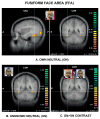What's in a smile? Maternal brain responses to infant facial cues
- PMID: 18595985
- PMCID: PMC2597649
- DOI: 10.1542/peds.2007-1566
What's in a smile? Maternal brain responses to infant facial cues
Erratum in
- Pediatrics. 2008 Sep;122(3):689
Abstract
Objectives: Our goal was to determine how a mother's brain responds to her own infant's facial expressions, comparing happy, neutral, and sad face affect.
Methods: In an event-related functional MRI study, 28 first-time mothers were shown novel face images of their own 5- to 10-month-old infant and a matched unknown infant. Sixty unique stimuli from 6 categories (own-happy, own-neutral, own-sad, unknown-happy, unknown-neutral, and unknown-sad) were presented randomly for 2 seconds each, with a variable 2- to 6-second interstimulus interval.
Results: Key dopamine-associated reward-processing regions of the brain were activated when mothers viewed their own infant's face compared with an unknown infant's face. These included the ventral tegmental area/substantia nigra regions, the striatum, and frontal lobe regions involved in (1) emotion processing (medial prefrontal, anterior cingulate, and insula cortex), (2) cognition (dorsolateral prefrontal cortex), and (3) motor/behavioral outputs (primary motor area). Happy, but not neutral or sad own-infant faces, activated nigrostriatal brain regions interconnected by dopaminergic neurons, including the substantia nigra and dorsal putamen. A region-of-interest analysis revealed that activation in these regions was related to positive infant affect (happy > neutral > sad) for each own-unknown infant-face contrast.
Conclusions: When first-time mothers see their own infant's face, an extensive brain network seems to be activated, wherein affective and cognitive information may be integrated and directed toward motor/behavioral outputs. Dopaminergic reward-related brain regions are activated specifically in response to happy, but not sad, infant faces. Understanding how a mother responds uniquely to her own infant, when smiling or crying, may be the first step in understanding the neural basis of mother-infant attachment.
Figures






References
-
- Kaitz M, Good A, Rokem AM, Eidelman AI. Mothers' and fathers' recognition of their newborns' photographs during the postpartum period. J Dev Behav Pediatr. 1988 Aug;9(4):223–6. - PubMed
-
- Kaitz M, Rokem AM, Eidelman AI. Infants' face-recognition by primiparous and multiparous women. Percept Mot Skills. 1988 Oct;67(2):495–502. - PubMed
-
- Green JA, Gustafson GE. Individual recognition of human infants on the basis of cries alone. Dev Psychobiol. 1983 Nov;16(6):485–93. - PubMed
-
- Kaitz M, Good A, Rokem AM, Eidelman AI. Mothers' recognition of their newborns by olfactory cues. Dev Psychobiol. 1987 Nov;20(6):587–91. - PubMed
-
- Liu D, Diorio J, Day JC, Francis DD, Meaney MJ. Maternal care, hippocampal synaptogenesis and cognitive development in rats. Nat Neurosci. 2000 Aug;3(8):799–806. - PubMed
Publication types
MeSH terms
Grants and funding
LinkOut - more resources
Full Text Sources
Medical

